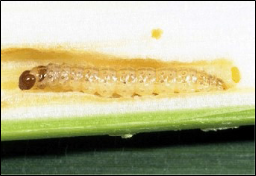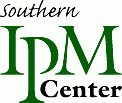European Corn Borer
European Corn Borer
Description
Fifteen to 35 white eggs are laid in masses on the underside of corn leaves, often near the midrib. The individual eggs overlap each other much like fish scales. Prior to hatching, the mass darkens.

European corn borer
University of Kentucky Dept. of Entomology
The black head capsule of the larva is distinct about 24 hours prior to hatch. Larvae are light tan in color and marked with small round brown spots. They vary from 1/8 inch long after hatch to about l inch long when full grown. The head may be red-brown to black.
Adult female moths are a pale yellow/brown with irregular darker bands running in wavy lines across the wings. The male moth is darker.
The first generation occurs in late May to late June. Early planted corn has greatest potential for damage. The second generation occurs in late June to August. Late planted corn is most attractive to this generation. A third generation occurs in late July and overwinters in the corn stems.
Damage
Results of feeding by small first generation borers appears as "window pane" or "shot holes" in the whorl leaves. Some borers enter leaf mid-ribs and cause them to break. Second generation damage includes feeding on stalks, tassels, ear shanks, leaf collars and developing kernels. Larvae may be found feeding on pollen and leaf tissue behind the leaf sheath and axil.
Please note: These dates are approximations only. This calendar was constructed using data from Kentucky, USA. These dates may not apply in your area. You may wish to contact your county extension agent or agricultural consultant for information tailored to your locality.
IPM Techniques and Scouting Procedures
First Generation
- Randomly select and examine 20 consecutive plants in each location in the field.
- Look carefully into whorls and count the number of plants showing fresh "shot hole" (window pane) damage on the leaves. Small areas of fresh surface feeding may seen before "shot holes" appear.
- Pull out the whorls of two damaged plants from each location and carefully unroll them, looking for small whitish borers with distinct (black) heads. Note the percentage of plants infested with live larvae and estimate the average size (l/8, l/4, l/2, 3/4 or l+ inches in length) of the larvae.
- Calculate percent damage by dividing the total number of plants with "shot hole" and "window pane" feeding by the total number of plants examined. Multiply this number by l00 and record as percent infestation on the scouting report form.
Second Generation
- Give special attention to late planted fields.
- Survey 20 plants per location.
- Check plants for egg masses and signs of borer feeding. Examine closely the lower surface of leaves and at the ear. When an egg mass is found, record the hatching stage according to following: white, cream, black head, hatched.
- Check the middle one-third of each plant for damage and live larvae. Second generation larvae are usually found feeding at the base of leaf sheaths. Pull leaves from the ear zone of one plant per location and record the number of larvae found in the leaf axil and their size (l/8, 1/4, l/2, 3/4, or l + inches in length). Calculate percent damage in the same manner as for first generation.
Economic Threshold
1st generation: Field corn controls should be considered if 50% of the plants show "shot hole" or "window pane" feeding damage and larvae are present. Treatment may be justified for popcorn and seed corn fields if 25% or more of the plants are infested. Once larvae have bored into the stalks, treatment will not be effective.
2nd generation: Treatment is suggested if egg masses average one per plant and egg hatch has begun or if 50% of the plants inspected have live larvae feeding on the leaves or tassels, in the leaf axils or behind sheaths. If your examination indicates that half of the larvae have entered the stalk, insecticide treatment is not recommended.
NOTE: Refer to the European Corn Borer computer decision management software available in your local (Kentucky) county cooperative extension office and/or ask them for a copy of ENT-49 for further information.
References and Additional Information
- IPM-2 Kentucky Corn IPM Manual
- ENTFACT 106 - Predicting European Corn Borer Development
- Current European Corn Borer Degree Day Totals for Kentucky


